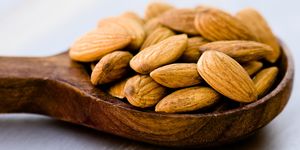As natural energy-boosters, almonds come loaded with good nutrition like many other nuts, but their high levels of fiber, vitamin E, proteins, and other important components just might make them best part of the trail mix. In fact, scientists have identified approximately 130 (!) different healthful compounds in these humble seeds.
So while the fat content can look alarming, don't worry. It's mostly the mono- and polyunsaturated kind that's great for your heart — and that's just the beginning of what almonds can do.
Nutrition Stats
Serving Size: 1 cup sliced almonds
- 533 calories
- 46 g total fat (71% DV)
- 3.5 g saturated fat (17% DV)
- 29 g monounsaturated fatty acids
- 11.2 g polyunsaturated fatty acids
- 20 g carbohydrates (7% DV)
- 12 g dietary fiber (48% DV)
- 19 g protein (38% DV)
- 247 mg calcium (25% DV)
- 3.41 mg iron (19% DV)
- 2.8 mg zinc (19% DV)
- 248 mg magnesium (62% DV)
- 15 mg phosphorus (44% DV)
- 167 mg potassium (14% DV)
- 23.58 mg vitamin E (79% DV)
- 50 mg choline
Almonds are rich in vegetable proteins, minerals, vitamins, antioxidants, and phytochemicals. Here's why it worth getting a little nutty:
Health Benefits of Almonds
- Reduced risk of heart disease: The polyphenols (a chemical compound) in almonds are thought to have an antioxidant effect, which improves cholesterol and lowers the likelihood of heart disease.
- Better blood sugar control: Almonds as part of a healthful diet may improve glycemic status in diabetic patients.
- Improved memory: Some research supports the link between eating almonds and cognitive function.
- Healthier gut microbiota: The abundance of dietary fiber and polyphenols in almonds may create a prebiotic effect.
Besides these powerful pluses, almonds work as both a filling snack and potential substitute for milk or flour. Here's what else you should know before stocking up on everything almond:
Are almonds a better choice than other nuts?
Almonds contain less fat than hazelnuts, macadamia nuts, pistachios, and walnuts. Of that group, almonds also contain the highest amounts of calcium, iron, magnesium, phosphorus, and zinc.
Is almond milk a good alternative for cow’s milk?
If you're lactose intolerant, vegan, or looking to avoid dairy, choose almond milk alternatives clearly labeled as unsweetened. Even “plain almond milk” can still contain added sugar — up to 18 grams per 8-ounce cup! You'll also want to check labels for sodium. Some flavored versions can contain up to 230 milligrams, even if they don't taste salty.
As for your kids, you might want to stick with cow’s milk for now if they don't have any dairy allergies. Drinking milk alternatives (like almond) has been associated with lower childhood height, possibly because they contain less fat and protein. However, future research is needed to better understand the relationship between drinking non-dairy milk and height.
What about almond butter?
Tired of regular PB&Js? Swap in almond butter, which is nutritionally similar to peanut butter. For a 2-tablespoon serving, both almond butter and peanut butter contain about 200 calories, 17 grams of fat, and 4 grams of fiber. Peanuts pack an extra gram of protein per serving (8 grams) than almonds (7 grams), but both will fill you up and stave off cravings for less nutritious foods.
Almond butter also includes higher amounts of vitamin E (triple what’s in PB!) plus some slightly more calcium, potassium, and magnesium — crucial blood pressure-balancing nutrients. Look for unsweetened butters without additives. The ingredients in peanut butter and almond butter alike should just be nuts and salt!
What's the deal with almond flour?
Made from blanched, ground almonds, almond flour provides a higher protein alternative to other grain-free flours. It's lower in saturated fat than coconut flour and just 2 tablespoons of the stuff can provide up to 15% of your daily value of vitamin E. Almond flour is perfect for those with celiac disease or gluten sensitivity, since it can replace traditional wheat flour in griddle cakes or baked goods.
How should I eat them?
Incorporate more of these nuts into your diet with four of our favorite almond-flavored recipes:
- Braised Chicken Thighs with Almonds and Olives
- Green Beans with Olive-Almond Tapenade
- Thyme-Roasted Marcona Almonds
- Almond-Crusted Creole Salmon
Looking for fuel on the go? Try these taste test-approved almond snacks:








No comments:
Post a Comment